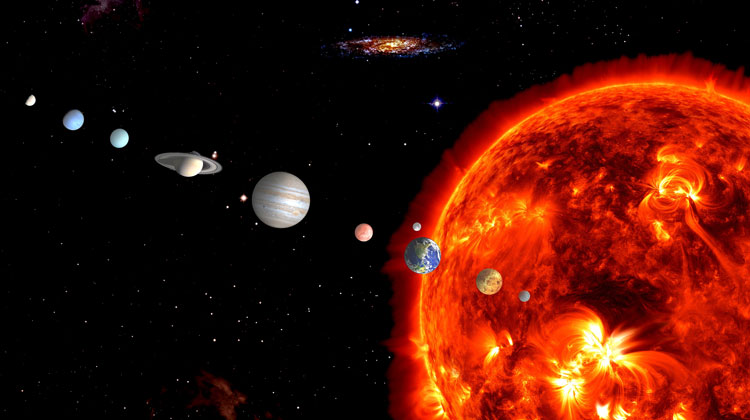The Sun is the largest object in our solar system and, thanks to its constant supply of heat and light, it allows all living things to exist on planet Earth. However, for something that’s omnipresent in our daily lives, few people think much about the sun. If you take the time to study it, though, it’s actually quite fascinating.
The sun is a Type I yellow dwarf star roughly 1.3 million times larger than the Earth. It is comprised almost entirely of hydrogen and helium, which are constantly fusing together to create new atoms. Through this process, the sun maintains its massive size and generates enough electromagnetic energy to supply the entire solar system with heat and light.
In this article, we’ll explore some of the fascinating facts about the sun. We’ll explain how the works and put into perspective just how massive it truly is. If you’ve ever had an interest in astronomy or space, now is the time to learn all you can about the center of our solar system.

How Big is the Sun?
The first person to measure the sun’s diameter was a Greek mathematician and astronomer named Aristarchus of Samos. In the 3rd century BCE, he calculated that the sun was about 20 times farther away from Earth than the moon and about 7 times wider than the Earth. While his measurements were not entirely accurate, they were close enough to give scientists a general idea of the sun’s size.
Today, we know that the sun’s diameter is about 1.4 million kilometers, which is about 109 times the diameter of the Earth. It’s so large that it could fit 1.3 million Earths inside of it.
Thanks to its gigantic size, we are able to visibly see the sun in the sky from 94 million miles away, which in perspective is actually quite close on a cosmic scale—Jupiter sits roughly half a billion miles away.
How Heavy is the Sun?
Much like early attempts at measuring the size of the sun, early estimates of the sun’s mass were widely incorrect. The first person to make a serious attempt was an English astronomer and mathematician John Michell. In 1784, he published a paper in which he proposed a method for measuring the mass of distant stars by measuring the amount of light deflected by a star’s gravity.
He calculated that the sun’s gravity would deflect light by about 0.0000007%. While this number is incredibly small, it’s actually within the range of modern-day instruments. Today, we now know that the sun’s mass is about 333,000 times that of the Earth, which means it has a combined mass of about 3.3 million Earths.
In simpler terms, it’s incredibly massive. In fact, the sun comprises 99.86% of the total mass in our solar system. The remaining 0.14% is made up of planets, asteroids, comets, and dust.
Additionally, the sun’s mass exerts a gravitational force so strong that it keeps everything in the solar system in orbit. If it were any smaller, Earth and the other planets would simply fly off into space.
How Does the Sun Work?
The sun is made up of hydrogen and helium atoms, which are the two simplest and most abundant elements in the universe. At the center of the sun, the pressure created by the sun’s own gravity generates an intense amount of heat and pressure, which are powerful enough to fuse hydrogen atoms together, forming helium. This is what’s known as nuclear fusion.
This process releases a tremendous amount of energy, which is what powers the sun and makes it so bright. As more and more energy is created through fusion, it forces the mass of the sun outward, preventing it from collapsing under its own gravitational force.
For the past 4.6 billion years, the sun has continued to undergo this process and is on track to do so for another 5 billion years.
Will the Sun Eventually Burn Out?
In a sense, no, the sun cannot burn out, however, this mostly has to do with the term “burning out”. To think of the sun as “burning” isn’t entirely correct. Although the sun may resemble a fire burning fuel, nuclear fusion doesn’t burn anything. Instead, it crushes together lightweight atoms into heavier, more complex atoms, expelling massive amounts of energy in the process.
Currently, the sun is still fusing hydrogen atoms into helium. Once it starts to run out of hydrogen, though, it will start fusing helium atoms into heavier elements, such as lithium and beryllium. At this point, the sun will begin to expand, becoming hotter and brighter, slowly growing into a red giant. In time, it will expand so far that it will consume Mercury, Venus, and the Earth.
This isn’t expected to happen for several billion years, though, at which point humanity will likely have gone extinct or left for another planet. In its end stage, the sun will become so bloated with heavy metals that it will not be powerful enough to support its own weight. In time, the sun will collapse inward, transforming it into a white dwarf.
From then on, the white dwarf left behind from our sun will spend the next quintillion years cooling into a crystallized black dwarf. Scientistic predict that this crystallized form would be made of electron-degenerate iron, producing very little light or radiation. To date, no white dwarf in the universe has quite reached this point, though, as the universe is not yet old enough.
Final Thoughts
Imagining what it must be like to witness the sun up close is mind-boggling and nearly impossible. Its sheer size, mass, gravitational pull, and the constant action of nuclear fusion are all unfathomable to the human mind.
In short, the sun is a fascinating object, and without it, life on Earth would not be possible. It’s hard to wrap your mind around something as large and complex as the sun, but hopefully, this article has given you a better understanding of our nearest star.
